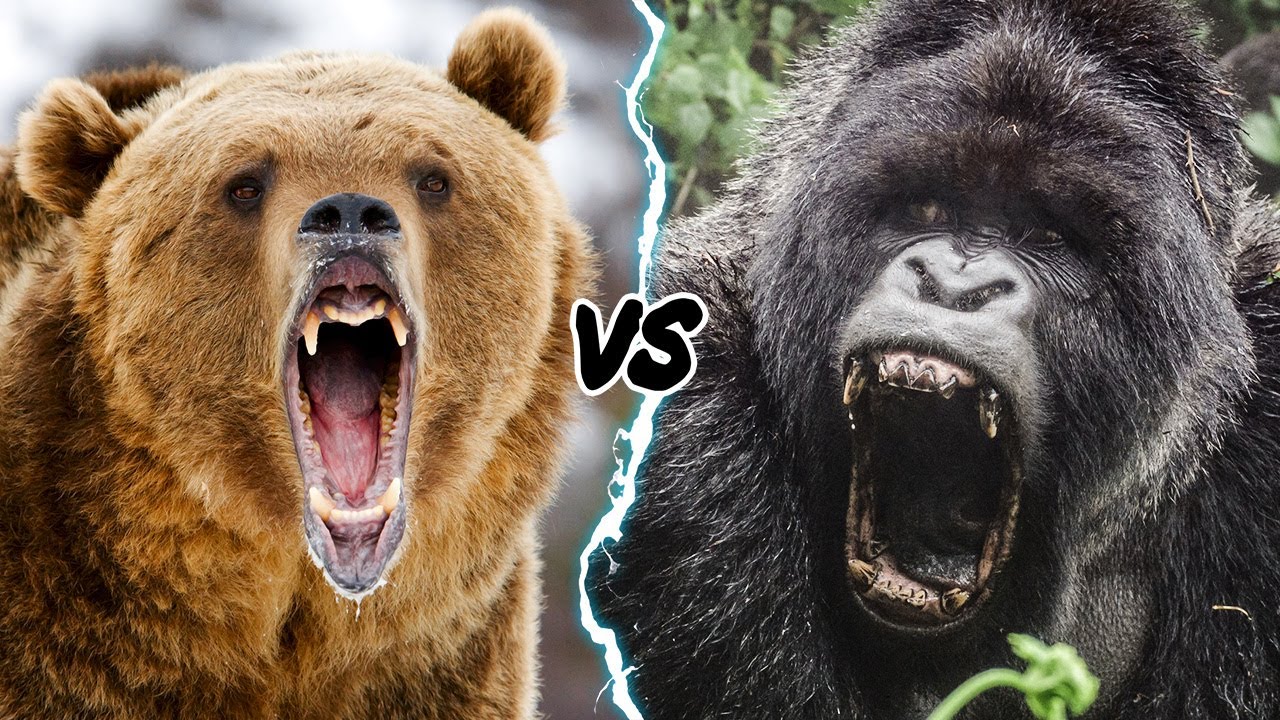Grizzly bears and silverback gorillas are two of the most powerful and impressive land animals on the planet. Both apex predators command attention and respect within their habitats. But how do these iconic beasts compare if matched against each other?
This article will analyze the strengths and attributes of Silverback Gorilla vs Grizzly Bear! Let’s see which would have the best chance of prevailing in a hypothetical matchup.
Defining Key Characteristics of Grizzlies and Silverbacks
Before comparing these powerful opponents, it’s important to define what makes each animal formidable.
Silverback gorillas are a subspecies of eastern gorilla native to the mountains and rainforests of central Africa. Named for the silver saddle of hair on the backs of mature males, silverbacks are the largest of the gorilla species, with males reaching up to 400 pounds.
Their long arms, immense strength, and sharp teeth make them a dominant force in their habitat. However, they are primarily herbivorous and live in protective family troops.
Grizzly bears inhabit North America, especially Alaska and Canada. A subspecies of brown bear, grizzlies can weigh up to 800 pounds at their peak. They are solitary, omnivorous, and highly territorial.
With lethal claws and jaws, thick fur and skin, brute strength, and surprising speed, grizzlies thrive in forests, mountains, and tundra. Their aggressive temperament and lack of natural predators solidify them as one of North America’s most dangerous animals.
Key Attributes of Silverback Gorillas
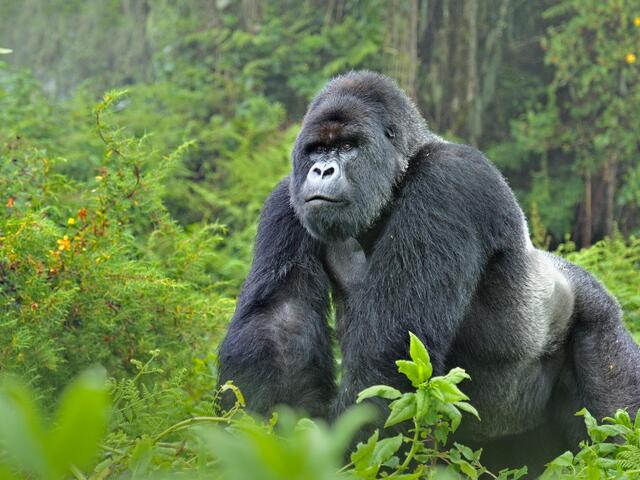
Silverback gorillas possess several key physical and behavioral attributes that aid their survival. These include:
- Immense strength– Pound for pound, silverbacks are estimated to be 4-10 times stronger than adult humans. Their muscular frame, adapted for climbing and defense, gives them incredible power.
- Tree-climbing adaptations– Long arms and dexterous hands help silverbacks scale trees rapidly despite their size. This aids foraging as well as escape from threats.
- Herbivorous diet– Silverbacks spend over half their day eating, focusing on fibrous vegetation like stems, bark, bamboo, and fruits. This diet influences their social structure and low-aggression temperament.
- Complex social structure– Silverbacks lead protective family troops of females and young. Social bonds provide security as well as opportunities to forage effectively and defend resources.
- Defensive weaponry– When confronted, silverbacks rely on intimidating displays of power, charging opponents, or delivering powerful strikes. Their jaws can bite with a force over 1,000 psi – twice that of a lion.
Key Attributes of Grizzly Bears

Like silverbacks, grizzly bears also boast impressive physical and behavioral adaptations, including:
- Sheer mass– The largest grizzlies can weigh up to 1,700 pounds, though 400-800 pounds is more typical. Either way, their brute strength is enough to dominance most opponents or prey within their habitat.
- Digging claws– Grizzlies have 4-inch, non-retractable claws specialized for digging burrows and roots or ripping into prey. Their powerful front limbs add to their already lethal mauling and striking abilities.
- Omnivorous opportunism– Grizzlies will eat almost anything, from berries and nuts to rodents, fish, carrion, and even trash. This provides the calories needed to sustain their imposing size and helps them thrive across habitats.
- Aggression when threatened– Unlike silverbacks, grizzlies are short-tempered when confronted. Standing their ground, vocalizing warnings, swatting, or charging are used to eliminate perceived threats definitively.
- Lack of predators– Aside from humans, grizzlies face little risk of predation even from packs of wolves thanks to their intimidating presence. This enables them to dominate food sources within their territory.
Key Differences: Silverback Gorilla vs Grizzly Bear
While silverbacks and grizzlies share common traits like strength and speed, they differ significantly in areas like diet, social structure, habitat, temperament, and more:
| Category | Silverback Gorillas | Grizzly Bears |
| Average Weight | 300-500 lbs | 400-850 lbs |
| Typical Group Size | 5-30 individuals | Solitary |
| Diet | Herbivorous | Omnivorous |
| Habitat | Tropical forests | Northern forests & tundra |
| Aggression Level | Low, mostly display | High, dangerous when provoked |
| Activity Cycle | Diurnal | Crepuscular |
| Defense | Intimidation, fleeing | Standing ground, charging |
| Predators | Leopards, humans | Humans only |
These differences influence how silverbacks and grizzlies interact with their environment. Gorillas rely more on strength in numbers and intimidation to maintain dominance, while bears use outright aggression and lack of competitors to rule their domain.
Strength and Power: Grizzly Bear Vs Silverback Gorilla
One key similarity between silverbacks and grizzlies that sparks endless debate is their incredible strength and power. Just how do these beasts compare by the numbers?
Silverback Strength
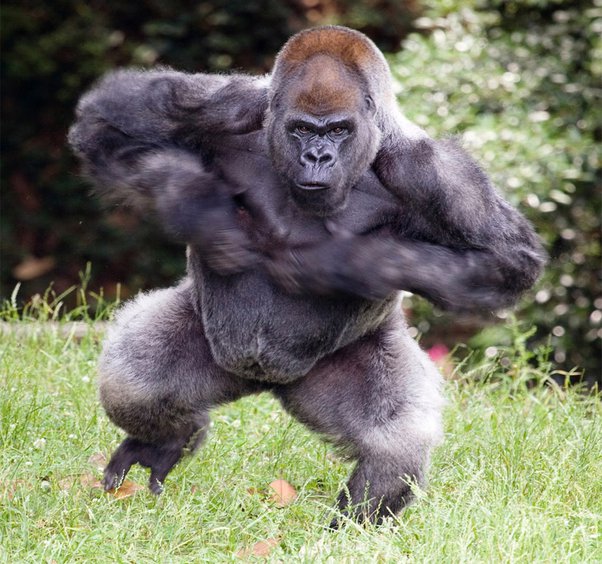
Silverbacks are estimated to have a strength advantage of 1:4 up to 1:10 over an average human. Some of their most impressive quantified strength feats include:
- Bending heavy steel bars and thick branches up to 10cm in diameter
- Moving objects weighing over 1,800 pounds
- Carrying items weighing over half their body weight with one arm
- Throwing heavy objects (like a tree trunk) up to 10 meters
- Exerting biting force over 1,000 psi – nearly double a lion
- Swinging rapidly between trees despite weight using only arms
Much silverback strength comes from short bursts rather than sustained efforts. Their muscular arms provide incredible striking and throwing leverage compared to their stocky legs. Still, exact upper limits are hard to safely measure outside of impressive anecdotes.
Grizzly Bear Strength

On the other end, grizzly bears mix tremendous strength with bursts of shocking speed and stamina. Some verified indicators of their power include:
- Lifting or dragging prey like moose or elk weighing over half a ton
- Turning over boulders and logs weighing up to 880 pounds
- Biting force around 1,250 psi – enough to crush bowling balls
- Swatting or throwing objects (like a tree stump) up to 30 meters away
- Out-dragging teams of horses or bulldozers in tug-of-war battles
- Disturbing/destroying human structures like sheds and tractors
Like silverbacks, grizzlies likely operate below their true strength capacity most of the time. Tests of grizzlies playing have shown swats with only 3⁄4 their full force. At peak rage or defensiveness, they exhibit shocking ability to overpower threats larger and stronger than themselves.
In Summary
While on paper their quantifiable strength overlaps, grizzly bears appear to demonstrate more raw power by a significant margin over gorillas. Silverbacks compensate with better dexterity and aggression displays. In reality, both animals wield far more strength than necessary in day-to-day life.
Habitats and Lifestyles: Silverback Gorilla vs Grizzly Bear
Another notable difference between the two animals lies in the habitats they occupy and resulting lifestyles.
Silverback Habitats
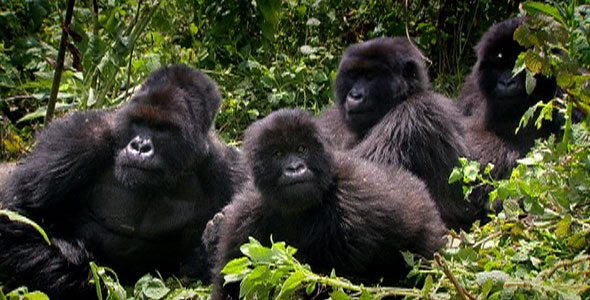
Silverback gorillas reside exclusively in the dense, humid rainforests and mountainous cloud forests of the Albertine Rift region in central Africa.
Gorilla habitats provide abundant arboreal food sources as well as sanctuary from terrestrial predators like leopards or poachers. However, this limits how large gorilla groups can grow before splintering off into separate troops – silverbacks require substantial vegetation to eat around 50 pounds of plants per day.
The warmth, shelter, and hydration of the rainforest allows for year-round gorilla activity and feeding. However, this also means gorillas have minimal fur or fat for insulation should they leave mountain refuges.
Grizzly Bear Habitats
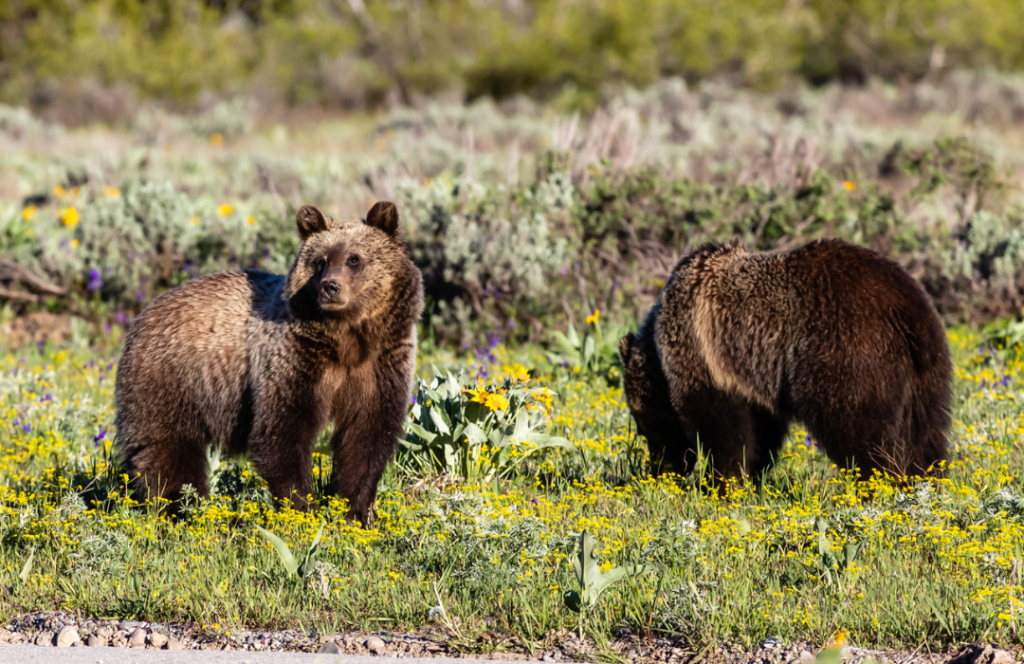
Meanwhile, grizzly bears occupy larger but more volatile habitats across western and northern North America. They thrive across:
- Temperate rainforests in coastal British Columbia and Alaska
- High elevation mountain forests and meadows in the Rockies
- Open tundra, prairies, and grasslands on flatlands
These diverse landscapes test grizzlies with seasonal extremes of weather, temperature, food availability, shelter, and more. For example, grizzlies must eat up to 90 pounds of food daily during autumn to pack on 200+ pounds of fat before colder months force them toward hibernation. Their size and adaptation to hyperphagia allows them to exploit many small food sources unavailable to silverbacks.
Ultimately, silverbacks develop expertise in finding sustenance and safety in smaller domains, while grizzly bears master demanding volatility across an array of habitats.
Diets: Silverback Gorilla vs Grizzly Bear
Differences in habitats and digestive anatomy also influence what silverbacks and grizzlies characteristically eat. This contributes to differences in size, strength, and temperament between them.
Silverback Diets
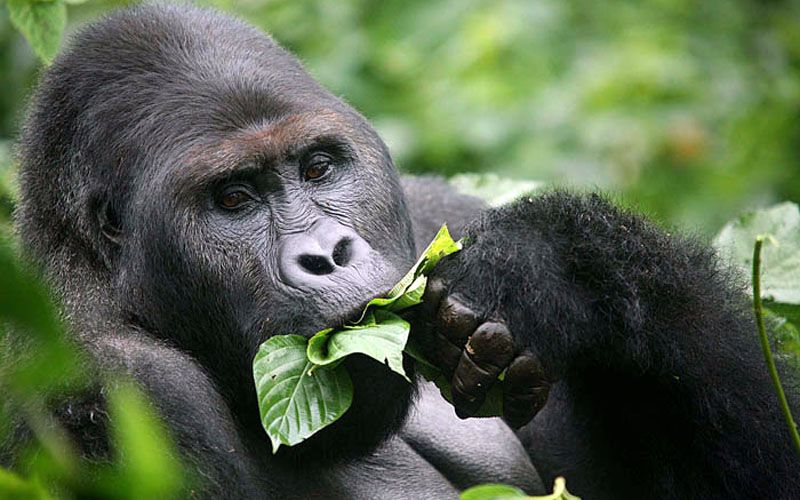
Gorillas like silverbacks are folivores that fill over 60% of their diet (and nearly 100% for mountain gorillas) with fibrous leaves, stems, bark, etc from abundant jungle vegetation. The rest consists of fruits, pith/shoots, and limited insects or small vertebrates on occasion.
This wholly-herbivorous diet provides sustenance but lacks dense caloric or nutrient density to enable much further size increases. As such, silverbacks remain trimmer, relying on lean strength and agility to navigate their habitat vertically.
Chewing tough vegetation throughout the day also wears down gorilla teeth rapidly. They compensate via wide jaws and ridges designed to grind plants effectively over their 30-40 year lifespan.
Grizzly Bear Diets
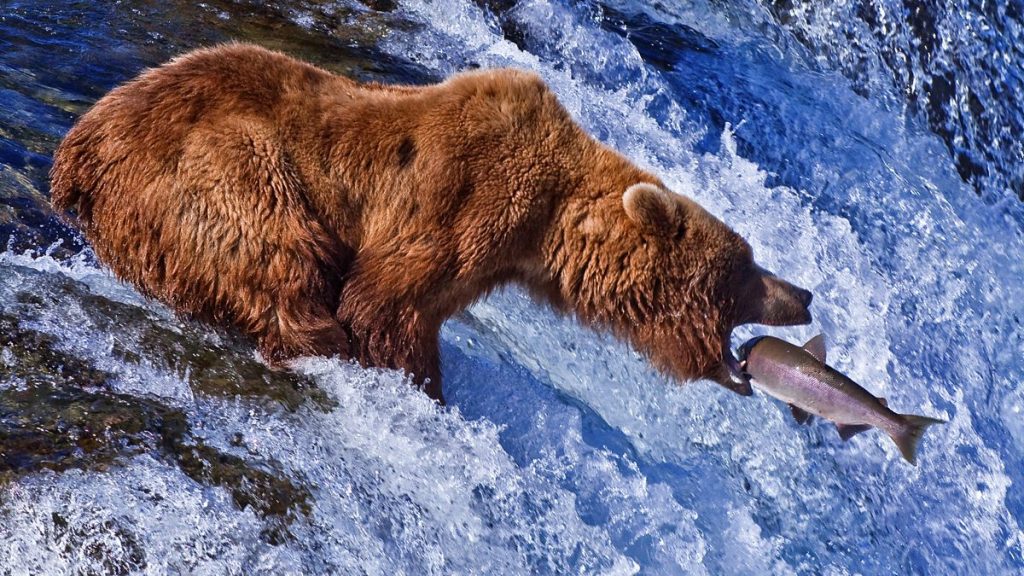
In contrast, grizzly bears are highly carnivorous opportunists. Up to 90% of their diet comes from animal protein, primarily fish like salmon or trout and mammals like deer, moose, caribou, or bison. Plant foods like roots, berries, and grasses supplement seasonally.
This richness combined with highly-acidic stomachs gives grizzlies nutrition to support much greater size and strength. Their varied omnivorous menu also provides calories to sustain six months of hibernation.
Grizzlies have evolved trenchant teeth that pierce and shred meat but wear down less quickly from plant chewing. Combined huge paws with long claws help them capture and demolish prey of nearly any size.
Ultimately their more predatory, protein-based diet fuels the robust and demanding metabolism of a grizzly bear year-round. Plants enable survival when hunting proves unreliable.
Aggression Levels: Grizzly Bear Vs Silverback Gorilla
While most imagine them as fearsome and short-tempered, differences also exist regarding aggression levels between silverbacks and grizzlies. This influences how each responds to potential confrontation.
Silverback Aggression

Despite their intimidating size and strength, silverback gorillas exhibit remarkably peaceable self-control from an herbivorous lifestyle. Docile and tolerant unless provoked, silverback troops communicate constantly via gestures, vocalizations, and nonviolent displays of dominance.
Physical aggression manifests mainly when defending food resources or family members from outsiders. Silverbacks rely primarily on shows of temporary strength rather than wanton brutality.
After all, excessive violence risks injury and threatens group cohesion critical to silverback survival. This enables complex social interrelations beyond merely mating rights.
That said, attacks on humans demonstrate exactly how destructive an enraged 400-pound silverback gorilla can become when sufficiently threatened. So while low overall aggression serves gorillas well, it should never be confused with pacifism or cowardice when confronted.
Grizzly Bear Aggression
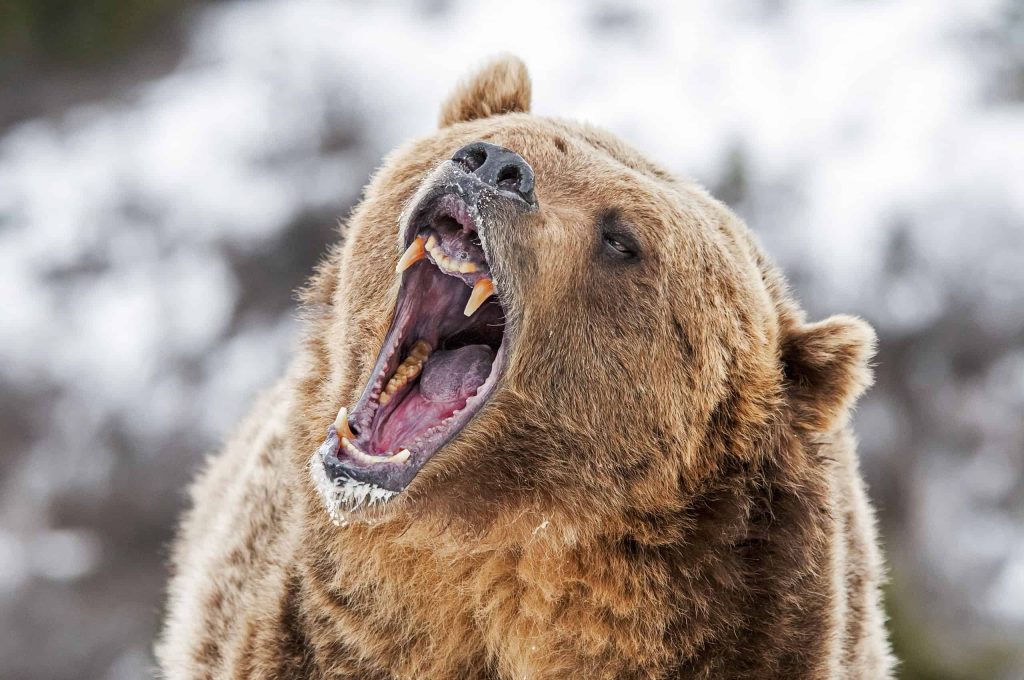
Conversely, grizzly bears command respect via infamously short fuses. Though not classically territorial, grizzlies fiercely defend temporary personal space and food resources needed to sustain themselves. Their solitary nature means all motivation focuses on self-interest rather than protecting offspring or social standing.
Perceived threats prompt aggressive displays like growling, paw swatting, bridling, or standing tall. These double as warnings and tests of an intruder’s reaction. Running carelessly may trigger predatory instinct and lead the bear to give chase more inclined toward attack.
If provoked or attacked directly, few animals can match a grizzly’s shocking ferocity, pain tolerance, and commitment to neutralizing a threat.
Under sustained threat, adrenaline surges may enable unbelievable feats of power. There are cases of mothers defending cubs holding off entire wolf packs despite dire injuries.
This serves grizzlies well against predators, but earns their unpredictable temper notorious fame. It’s critical to avoid sudden moves, direct eye contact, or proximity invading their personal zone.
In Summary
Silverbacks rely more on shows of strength and intimidation before attacking. Grizzly attacks serve more as definitive preemptive measures against possible dangers. Gorillas mainly attack under provocation, while grizzlies may chase down perceived threats proactively. Neither should ever be carelessly engaged.
Silverback Gorilla Defenses

When a silverback senses confrontation or danger from predators like leopards, they rely on several defensive tactics:
Intimidating displays are the first recourse to discourage aggression. Standing tall, aggressive barking, chest-beating, mock charges, throwing objects, or piloerection (making their hair stand on end) all aim to convince rivals to back down without violence.
Mob attacks see multiple silverbacks striking or biting a threat simultaneously to drive it away through pain and intimidation. This defense privileges safety in numbers over more dangerous solo combat.
Sprinting short distances enables silverbacks to charge opponents or escape into the trees rapidly thanks to muscular legs. However, gorillas lack sustained speed or agility advantages against most predators.
When defending juveniles, the silverback may place them in a protected huddle while keeping the threat in sight. Other silverbacks or mothers might throw vegetation to distract the danger. Tactical positioning limits vulnerable angles of attack.
As a last resort, the silverback may directly attack predators with charges, grappling, and devastating canine bites aiming to inflict critical injury. However, prolonged combat remains extremely risky overall for gorillas and thus rare.
Climbing trees enables silverbacks to survey threats safely from hard-to-reach locations. However, this also limits strike opportunities while exposing the vulnerable gorilla troop below. Thus silverbacks only climb trees as an absolute last defensive measure.
Grizzly Bear Defenses
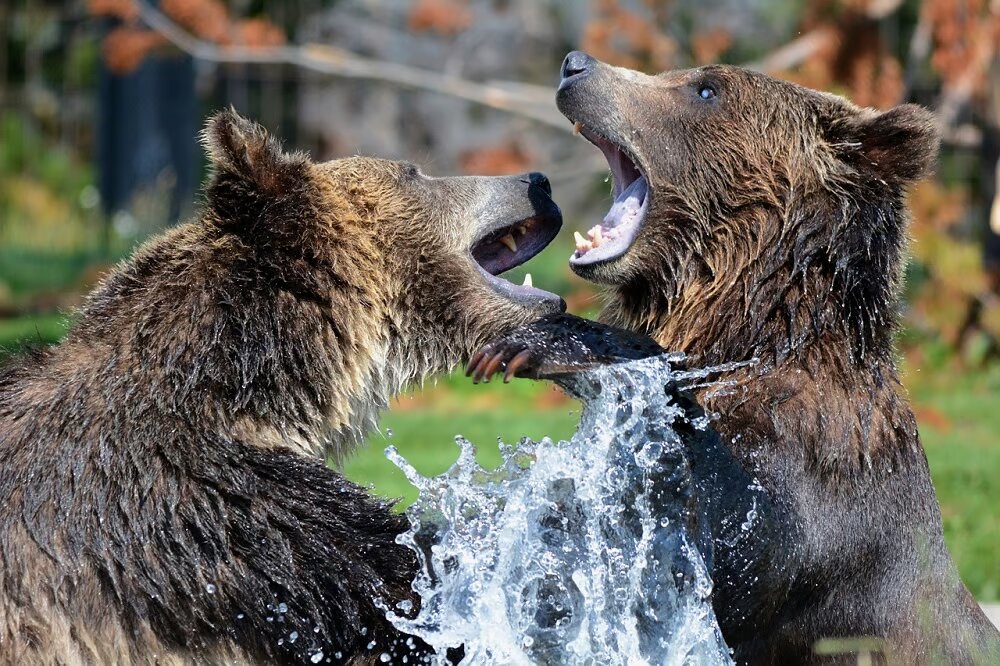
In contrast, grizzly bears demonstrate more singularly ruthless tactics when confronted with danger:
Standing their ground against threats allows grizzlies to display aggression through growling, mock charges, swatting, or bluffing. Opponents who flee may trigger pursuit and attack, while those holding ground demonstrate courage to deserve coexisting more peacefully.
Intimidating size combines with paw swipes or charges to eliminate over 90% of threats without requiring actual combat. Enemies recognizing grizzly power who wisely withdraw face little lasting wrath. However, those appearing weak, clumsy, stubborn, or oblivious prompt merciless teaching.
Violent mauling joins bone-crushing bites with five-knife slashes across enemy flanks. The bear tackles, pins, and overwhelms victims, ceaselessly attacking vulnerabilities until all movement stops. Only ammunition, severe trauma, or death typically convinces a grizzly to disengage willingly.
Remarkable endurance allows angry grizzlies to sustain horrific injury while dishing out monstrous retaliation. Their brute force, pain tolerance, and commitment to victory fuel relentless assault. Even facing death, a grizzly may devastate multiple deadly opponents at the cost of its own life.
Key Behavioral Differences Impacting Combat
The above comparisons highlight pronounced behavioral differences between gorillas and bears relevant to this hypothetical matchup:
Social Structure – Silverbacks operate in protective troops, enabling outnumbering strategies. Solitary grizzlies rely purely on self without coordination.
Typical Aggression – Low silverback aggression unless protecting food or family. Grizzlies have hair-trigger aggression toward unfamiliar encroachers.
Tendency Toward Combat – Silverbacks generally avoid combat, preferring intimidation or concealment to put themselves at risk. Grizzlies readily initiate violence against potential threats.
Combat Tactics – Silverbacks strike or grapple using hands and bites when engaging enemies directly. Grizzlies tackle, slash/bite simultaneously, targeting vulnerability.
Object Use – Silverbacks throw objects or swing branches to intimidate threats. Grizzlies lack manual dexterity but can bowl over most animate threats directly.
Escape Options – Silverbacks sprint short distances & climb trees rapidly despite size. Grizzlies run 30+ mph longer term, but climb trees poorly due to immense weight.
These differences provide insights into how hypothetical showdowns might unfold. Silverbacks leverage numbers, intimidation, or concealment to mitigate combat liability while grizzlies resolutely lean into violence to seize dominance immediately. How do their weapons compare under fire?
Key Offensive Weapons Comparison
Both beasts wield deadly natural weaponry sure to leave traumatic impacts during intense clashes:
Silverback Gorilla Weapons
Arms – Long, dense arm bones and five-fingered hands enable forceful striking/grappling. Hands can manipulate objects or grip to rend flesh.
Canine Teeth – Prominent 2” fangs plus large molars generate incredible bite force concentrated across vulnerable anatomy.
Sheer Strength – Immense power manifesting through short-range throwing/striking or grappling to dismember opponents violently.
Team Attacks – Multiple silverbacks overwhelming targets simultaneously with coordinated grabs, tackles, pulling, and biting across areas. Difficult to defend despite greater individual damage threats elsewhere.
Grizzly Bear Weapons
Claws – Five 4-6” retractable talons bring slicing, stabbing, gripping power to front & hind paws. Devastating both offensively and for grappling against strikes/bites targeting the bear’s vulnerable zones.
Canine Teeth – 2” fangs plus crushing molars generate ~1,250 psi bites. Focused gnawing and shaking dismembers thick hides, tendons, and bones rapidly.
Sheer Strength – Enormous shoulder/paw swipes or tackles knock most objects airborne easily, while pinning strength makes escapes nearly impossible without serious injury.
Rushing Tackles – Attacking at 35+ mph from short range, grizzlies combine huge momentum with weight, claws, and bites to overwhelm victims physically via intense shock & trauma simultaneously. Few opponents can withstand this onslaught at peak ferocity.
Durability – Alongside offense, grizzlies boast such physical durability that even mortal wounds may not halt their sustained assault. Dense fur/fat layers require tremendous penetrating trauma alongside blood loss to fully incapacitate angry bears. Only brain or spine destruction reliably stops them.
Final Verdict
Grizzlies and gorillas both demonstrate incredible strength and intimidation factor. However, grizzlies possess more singularly violent temperaments, whereas silverbacks rely more on displays and group coordination for defense.
Bears also benefit from more formidable natural weapons like sweeping claws for slashing or disemboweling opponents. Their biting power essentially matches that of silverbacks as well. This combines with a considerable size advantage for grizzlies along with past experiences defeating natural predators like tigers or wolves in confrontations.
Despite their herbivorous nature, silverbacks remain incredibly strong and ruthless when defending their families. Their manual dexterity provides additional tactics like throwing objects or using environmental elements as weapons that grizzlies lack. However, bears showcase remarkably pain tolerance and tenacity empowering them to sustain horrific injury while continuing a sustained assault.
Hugues Beaufrere is the Exoticpetia’s senior writer and reptile expert. He has been fascinated by reptiles and monkeys since he was a kid and had years of experience in herpetology and primatology. He has cared for various kinds of Monkeys, Lizards and Reptiles and loves to share his knowledge and passion with others.

